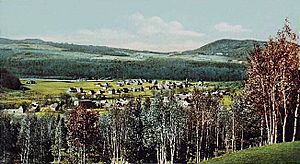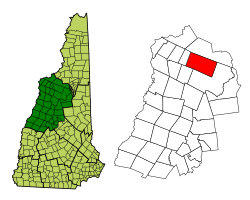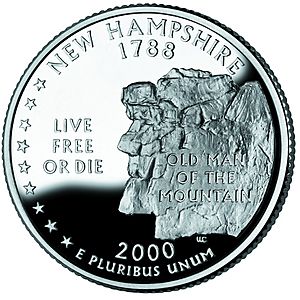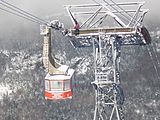Franconia, New Hampshire facts for kids
Quick facts for kids
Franconia, New Hampshire
|
|
|---|---|
|
Town
|
|

Franconia Village with Sugar Hills background c. 1908
|
|
| Motto(s):
"Explore the Road Not Taken"
|
|

Location in Grafton County, New Hampshire
|
|
| Country | United States |
| State | New Hampshire |
| County | Grafton |
| Incorporated | 1764 |
| Area | |
| • Total | 65.8 sq mi (170.5 km2) |
| • Land | 65.5 sq mi (169.7 km2) |
| • Water | 0.3 sq mi (0.8 km2) 0.47% |
| Elevation | 928 ft (283 m) |
| Population
(2020)
|
|
| • Total | 1,083 |
| • Density | 17/sq mi (6.4/km2) |
| Time zone | UTC-5 (Eastern) |
| • Summer (DST) | UTC-4 (Eastern) |
| ZIP code |
03580
|
| Area code(s) | 603 |
| FIPS code | 33-27300 |
| GNIS feature ID | 0873599 |
Franconia is a small town in Grafton County, New Hampshire, United States. In 2020, about 1,083 people lived there. Franconia is located in the beautiful White Mountains. It is home to the northern part of Franconia Notch State Park. You can also find parts of the White Mountain National Forest in the eastern and southern areas of the town. The famous Appalachian Trail also goes through Franconia.
Contents
History of Franconia

Franconia first became a town in 1764. It was named by the British Governor, Benning Wentworth. He thought the area looked like the Franconian Switzerland region in Germany.
Later, in 1772, the town was given a new name, "Morristown." This happened because some people claimed the first settlement rules were not followed. But after a legal fight, the original name, Franconia, was brought back.
The town sits on a rich deposit of iron. In the past, this iron was used to make tools for farms and other metal items.
Franconia is famous for the Cannon Mountain Aerial Tramway. This tramway takes people up to the top of Cannon Mountain, which is about 4,100 feet high. When it was built in 1938, it was the first passenger tramway in all of North America!
The first tramway carried over 6.5 million passengers before it was replaced in 1980. The new tramway, which holds 80 passengers, is still running today. You can ride the red and yellow tram cars all year round.
Around 1940, a famous actress named Bette Davis was visiting nearby. She got lost while hiking to Bridal Veil Falls. A man named Arthur Farnsworth found her and helped her. They later fell in love and got married. Sadly, Arthur passed away unexpectedly. Bette Davis placed a special plaque on a rock on the trail to remember him. It says "The Keeper of Stray Ladies." You can still see this plaque today on the Coppermine Trail.
Franconia was also home to Franconia College in the 1960s and 1970s. More recently, the town has been known as the home of skier Bode Miller. He has won many medals in the Olympics!
Geography and Nature
Franconia covers about 65.8 square miles (170.5 square kilometers). Most of this area is land, with a small amount of water. Several rivers and streams flow through Franconia, including the Pemigewasset River and the Gale River.
The area called Franconia Notch is well-known for its amazing natural sights. These include Profile Lake and Echo Lake. You can also see huge mountains like Mount Lafayette, Mount Lincoln, and Cannon Mountain.
Mount Lafayette is the tallest peak in Franconia, standing at 5,249 feet (1,600 meters) above sea level. It's also the second most important peak in the White Mountains after Mount Washington.
A very famous rock formation called the Old Man of the Mountain used to be on the side of Cannon Mountain. It looked like a man's face! This natural wonder inspired a famous story called "The Great Stone Face" by Nathaniel Hawthorne. Sadly, the Old Man of the Mountain collapsed on May 3, 2003.
Besides the mountains around Franconia Notch, there are other tall peaks in the town. These include Mount Garfield, Galehead Mountain, South Twin Mountain, and Owl's Head.
-
Echo Lake c. 1905
-
Cannon Mountain rising over Franconia village in 2007
Population Facts
| Historical population | |||
|---|---|---|---|
| Census | Pop. | %± | |
| 1790 | 72 | — | |
| 1800 | 129 | 79.2% | |
| 1810 | 358 | 177.5% | |
| 1820 | 373 | 4.2% | |
| 1830 | 443 | 18.8% | |
| 1840 | 523 | 18.1% | |
| 1850 | 584 | 11.7% | |
| 1860 | 708 | 21.2% | |
| 1870 | 549 | −22.5% | |
| 1880 | 550 | 0.2% | |
| 1890 | 594 | 8.0% | |
| 1900 | 655 | 10.3% | |
| 1910 | 504 | −23.1% | |
| 1920 | 440 | −12.7% | |
| 1930 | 514 | 16.8% | |
| 1940 | 568 | 10.5% | |
| 1950 | 549 | −3.3% | |
| 1960 | 491 | −10.6% | |
| 1970 | 655 | 33.4% | |
| 1980 | 743 | 13.4% | |
| 1990 | 811 | 9.2% | |
| 2000 | 924 | 13.9% | |
| 2010 | 1,104 | 19.5% | |
| 2020 | 1,083 | −1.9% | |
| U.S. Decennial Census | |||
In 2000, there were 924 people living in Franconia. About 27% of the homes had children under 18. The average age of people living in Franconia was 47 years old.
Fun Places to Visit
- The Frost Place: This was the home of the famous poet Robert Frost.
- New England Ski Museum: Learn all about skiing in New England!
- Franconia Notch State Park & Cannon Mt Aerial Tramway: Explore beautiful nature and ride the tramway.
- Bridal Veil Falls: A lovely waterfall to visit.
- Profile House: A historic spot.
- Franconia Iron Works: Learn about the town's iron history.
Famous People from Franconia
- Elisabeth Elliot (1926–2015): A Christian author and speaker.
- Jessica Garretson Finch (1871–1949): She helped women get the right to vote and started Finch College.
- Robert Frost (1874–1963): A famous poet who won the Pulitzer Prize four times.
- Sel Hannah (1913–1991): A skier and designer of ski areas.
- Bode Miller (born 1977): An Olympic gold medalist in skiing.
- Ernest Poole (1880–1950): An author.
- Annie Trumbull Slosson (1838–1926): An author and expert on insects.
See also
 In Spanish: Franconia (Nuevo Hampshire) para niños
In Spanish: Franconia (Nuevo Hampshire) para niños







